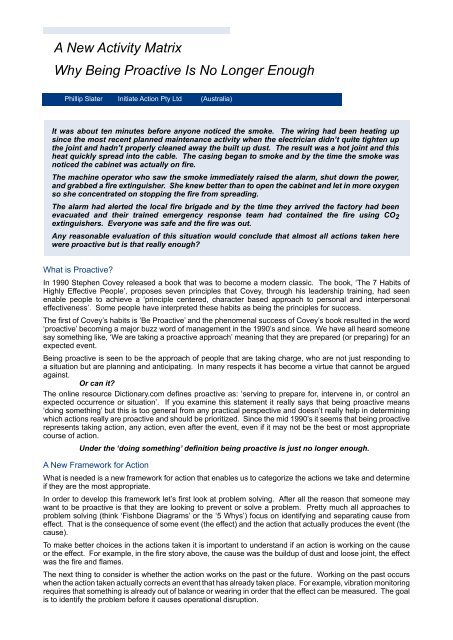SKF Reliability Systems - Library
SKF Reliability Systems - Library
SKF Reliability Systems - Library
You also want an ePaper? Increase the reach of your titles
YUMPU automatically turns print PDFs into web optimized ePapers that Google loves.
A New Activity Matrix<br />
Why Being Proactive Is No Longer Enough<br />
Phillip Slater Initiate Action Pty Ltd (Australia)<br />
It was about ten minutes before anyone noticed the smoke. The wiring had been heating up<br />
since the most recent planned maintenance activity when the electrician didn’t quite tighten up<br />
the joint and hadn’t properly cleaned away the built up dust. The result was a hot joint and this<br />
heat quickly spread into the cable. The casing began to smoke and by the time the smoke was<br />
noticed the cabinet was actually on fire.<br />
The machine operator who saw the smoke immediately raised the alarm, shut down the power,<br />
and grabbed a fire extinguisher. She knew better than to open the cabinet and let in more oxygen<br />
so she concentrated on stopping the fire from spreading.<br />
The alarm had alerted the local fire brigade and by the time they arrived the factory had been<br />
evacuated and their trained emergency response team had contained the fire using CO2<br />
extinguishers. Everyone was safe and the fire was out.<br />
Any reasonable evaluation of this situation would conclude that almost all actions taken here<br />
were proactive but is that really enough?<br />
What is Proactive?<br />
In 1990 Stephen Covey released a book that was to become a modern classic. The book, ‘The 7 Habits of<br />
Highly Effective People’, proposes seven principles that Covey, through his leadership training, had seen<br />
enable people to achieve a ‘principle centered, character based approach to personal and interpersonal<br />
effectiveness’. Some people have interpreted these habits as being the principles for success.<br />
The first of Covey’s habits is ‘Be Proactive’ and the phenomenal success of Covey’s book resulted in the word<br />
‘proactive’ becoming a major buzz word of management in the 1990’s and since. We have all heard someone<br />
say something like, ‘We are taking a proactive approach’ meaning that they are prepared (or preparing) for an<br />
expected event.<br />
Being proactive is seen to be the approach of people that are taking charge, who are not just responding to<br />
a situation but are planning and anticipating. In many respects it has become a virtue that cannot be argued<br />
against.<br />
Or can it?<br />
The online resource Dictionary.com defines proactive as: ‘serving to prepare for, intervene in, or control an<br />
expected occurrence or situation’. If you examine this statement it really says that being proactive means<br />
‘doing something’ but this is too general from any practical perspective and doesn’t really help in determining<br />
which actions really are proactive and should be prioritized. Since the mid 1990’s it seems that being proactive<br />
represents taking action, any action, even after the event, even if it may not be the best or most appropriate<br />
course of action.<br />
Under the ‘doing something’ definition being proactive is just no longer enough.<br />
A New Framework for Action<br />
What is needed is a new framework for action that enables us to categorize the actions we take and determine<br />
if they are the most appropriate.<br />
In order to develop this framework let’s first look at problem solving. After all the reason that someone may<br />
want to be proactive is that they are looking to prevent or solve a problem. Pretty much all approaches to<br />
problem solving (think ‘Fishbone Diagrams’ or the ‘5 Whys’) focus on identifying and separating cause from<br />
effect. That is the consequence of some event (the effect) and the action that actually produces the event (the<br />
cause).<br />
To make better choices in the actions taken it is important to understand if an action is working on the cause<br />
or the effect. For example, in the fire story above, the cause was the buildup of dust and loose joint, the effect<br />
was the fire and flames.<br />
The next thing to consider is whether the action works on the past or the future. Working on the past occurs<br />
when the action taken actually corrects an event that has already taken place. For example, vibration monitoring<br />
requires that something is already out of balance or wearing in order that the effect can be measured. The goal<br />
is to identify the problem before it causes operational disruption.

















